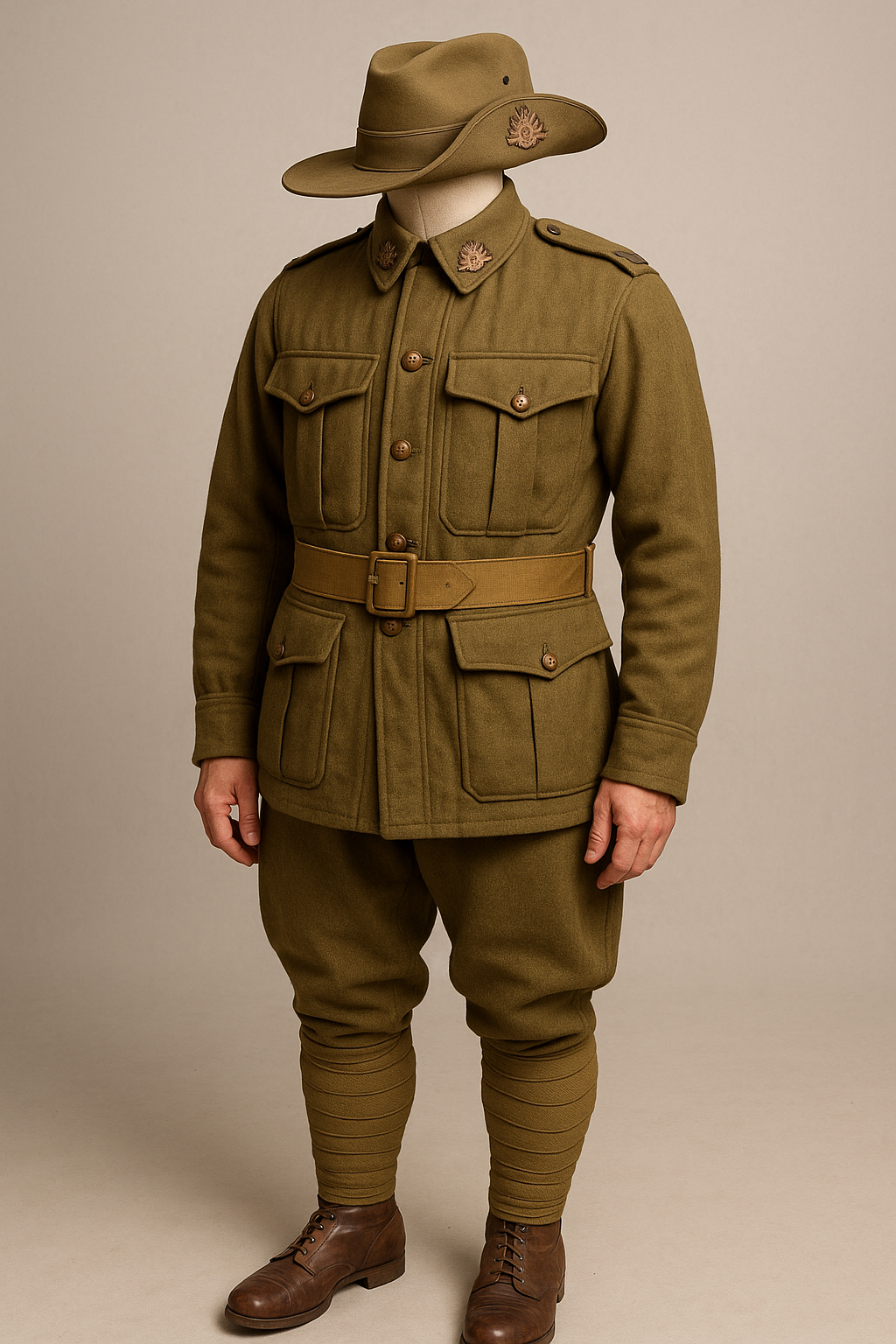
WW1 Uniforms Australia: A Deep Dive into History, Authenticity & Modern Collecting Trends
Published on Sep 21, 2025
WW1 Uniforms Australia: A Deep Dive into History, Authenticity & Modern Collecting Trends
Introduction:
Did you know that over 416,000 Australians enlisted during WW1, and their uniforms became a symbol of national identity and sacrifice?
Today, these pieces of history are highly sought after by collectors, historians, and reenactors. Whether you're passionate about Australian WWI uniforms, diving into the world of militaria, or starting your own collection, understanding the WW1 uniforms Australia used can be both rewarding and educational.
This guide is your complete roadmap to navigating the fascinating world of Australian military uniforms, especially those from WW1 and WW2. Let’s uncover the history, buying tips, preservation tricks, and current market trends that matter today.
🪖 Understanding WW1 Uniforms Australia: A Brief History
The Australian World War 1 uniform evolved as part of the broader British Commonwealth military system, yet had unique features that set it apart.
Key Features of WW1 Australian Uniforms:
- Color: A distinctive khaki wool material suitable for trench warfare.
- Slouch Hat: A symbol of Australian identity, often pinned with the Rising Sun badge.
- Rising Sun Insignia: A signature badge on collars and hats, representing national pride.
- Puttees: Long strips of cloth wrapped around the lower legs.
- Shoulder Titles: Identifying the soldier’s unit or corps.
These uniforms were functional yet symbolic — blending durability with national identity. Recognizing the small variations over time is key to identifying authentic pieces.
🔍 How to Identify Authentic Australian World War 1 Uniforms
If you're collecting or studying Australian WWI uniforms, verifying authenticity is crucial. Here’s how you can do it:
✅ Actionable Steps:
- Look for Original Badges & Insignia:
- Original Rising Sun badges from WW1 were made from brass with specific maker's marks.
- Shoulder titles should be sewn-in, not pinned (as seen in modern reproductions).
- Examine the Fabric:
- WW1 tunics were made from heavy khaki wool, not the lighter material used in modern replicas.
- Inspect Stitching & Labels:
- Authentic uniforms may contain a faded or partially legible military issue tag.
- Check for consistent hand or early machine stitching.
- Use a UV Light:
- Reproduction fabrics often glow under UV light due to synthetic fibers. Originals usually don’t.
❌ Common Pitfalls:
- Buying online from non-reputable sources.
- Confusing WW2 and WW1 uniforms due to similar color schemes.
- Failing to ask for provenance or documentation when purchasing.
🧵 WW1 Uniforms Australia vs. WW2 Uniforms: Spot the Difference
It’s easy to mix up Australian WWI uniforms and Australian WWII uniforms, but collectors must know the difference.
FeatureWW1 UniformWW2 Uniform
Material : Thicker wool, rougher texture . Slightly finer wool
Tunic Pockets 4 with pleats and scalloped flaps often flatter with simpler designs
Badges , Early brass Rising Sun, marked . Later versions with different shapes
Helmet Brodie helmet was introduced later more standardized across forces
Knowing these differences helps you accurately classify and appraise your finds.
💼 For Collectors: How to Start Your WW1 Uniform Collection in Australia
Start With These Essentials:
- Slouch Hat with badge
- Tunic with shoulder titles
- Breeches or trousers
- Puttees and boots
Where to Find Authentic Pieces:
- Local militaria fairs in Sydney, Melbourne, or Brisbane
- Online militaria dealers (with a good reputation)
- Auction houses specializing in war memorabilia
- Military museums sometimes have ex-display items for sale
Budgeting Tips:
- Expect to pay anywhere from $500–$2500 for a full, authentic set.
- Reproductions can be significantly cheaper but lack collector value.
🔥 Current Trends in Australian Military Uniform Collecting
The militaria market is evolving, and here’s what’s hot right now:
Trending:
- WW1 nurse uniforms and medical corps attire
- Anzacs on the Western Front–related uniforms
- Digitally authenticated items using blockchain tech
- Growing interest in the restoration of original uniforms
- Increasing popularity of reenactment-ready kits
Collecting Tip:
Authenticity verification tools and historical databases are becoming more common—use them before finalizing purchases.
🧼 Caring for Your Australian Uniform: Preservation Tips
These uniforms are 100+ years old. Keep them that way by following good preservation techniques.
Do:
- Store in a dry, cool area away from sunlight.
- Use acid-free tissue paper to maintain shape.
- Hang using padded hangers or lay flat in archival boxes.
Don’t:
- Wash with modern detergents.
- Expose to direct sunlight or humidity.
- Iron, unless guided by a textile conservator.
💬 Real Example: A Collector’s Experience
James W., a Brisbane-based collector, shares:
“I bought what I thought was a WW1 tunic online. Turned out to be a WW2 piece dyed to look older. I learned to always ask for provenance and close-up photos before buying.”
His experience highlights how easy it is to be misled — and why knowledge is your best tool.
📚 Resources for Deeper Learning
- Australian War Memorial Archives – Access photos, documents, and original service records.
- Military Heraldry & Technology Collection (AWM)
- Books:
- Khaki: Uniforms of the Australian Army by Peter N. Sadler
- The Australian Army in World War I by Ian Sumner
🏁 Conclusion: Keep History Alive with WW1 Uniforms Australia
Whether you're a history buff, reenactor, or serious collector, understanding and preserving the WW1 uniforms Australia used is both a passion and a responsibility. From identifying authentic pieces to avoiding pitfalls and spotting trends in Australian military uniforms, this journey opens doors to deep historical insight.
Now that you’re equipped with knowledge, start exploring local fairs, connect with collectors, and build your own piece of living history.
